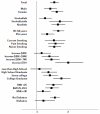Prehypertension, racial prevalence and its association with risk factors: Analysis of the REasons for Geographic And Racial Differences in Stroke (REGARDS) study
- PMID: 20864944
- PMCID: PMC3468299
- DOI: 10.1038/ajh.2010.204
Prehypertension, racial prevalence and its association with risk factors: Analysis of the REasons for Geographic And Racial Differences in Stroke (REGARDS) study
Abstract
Background: There are few available data on the epidemiology of prehypertension (preHTN). To determine racial, clinical, and demographic differences in the prevalence of preHTN and its cross-sectional association with vascular risk factors.
Methods: Cross-sectional analysis of 5,553 prehypertensives, 20,351 hypertensive's, and 4,246 nonhypertensive participants (age ≥45), from a population-based national cohort study (REasons for Geographic And Racial Differences in Stroke (REGARDS) total population 30,239, of whom 30,150 had adequate blood pressure (BP) measurements) enrolled from January 2003-October 2007 with oversampling from the southeastern stroke belt, and black individuals. Baseline data were collected using a combination of telephone interview and in-home evaluation. preHTN was defined according to The Seventh Report of the Joint national Committee on Prevention, Detection, Evaluation, and Treatment of High Blood Pressure (JNC 7) guidelines.
Results: The prevalence of preHTN was associated with age and black race (62.9% in blacks compared to 54.1% in whites). A higher prevalence of preHTN was observed in obese individuals, self-reported heart disease; and, those with elevated high-sensitivity C reactive protein (hsCRP), diabetes, and microalbuminuria compared to those without these factors. Heavy alcohol consumption in white participants was associated with increased odds of preHTN (odds ratio (OR) = 1.32) but was even greater in black participants (OR = 2.27).
Conclusion: The prevalence of preHTN increased by age and African-American race. In addition, a higher prevalence of preHTN was observed with elevated hsCRP, diabetes, microalbuminuria, and those with heavy alcohol consumption compared to those without these factors.
Figures
Comment in
-
Highlights: Are race and ethnicity playing a useful structural role in epidemiologic research?Am J Hypertens. 2011 Feb;24(2):121. doi: 10.1038/ajh.2010.253. Am J Hypertens. 2011. PMID: 21248729 No abstract available.
References
-
- Chobanian AV, Bakris GL, Black HR, Cushman WC, Green LA, Izzo JL, Jr, Jones DW, Materson BJ, Oparil S, Wright JT, Jr, Roccella EJ. The Seventh Report of the Joint National Committee on Prevention, Detection, Evaluation, and Treatment of High Blood Pressure: the JNC 7 report. JAMA. 2003 May 21;289(19):2560–2572. - PubMed
-
- Qureshi A, Suri MFK, Kirmani JF, Divani AA, Mohammad Y. Prehypertension triples heart attack risk. Health and Medicine. ScienceDaily. from http://www.sciencedaily.com/releases/2005/08/050805110759.htm.
-
- Gu Q, Burt VL, Paulose-Ram R, Yoon S, Gillum RF. High blood pressure and cardiovascular disease mortality risk among U.S. adults: the third National Health and Nutrition Examination Survey mortality follow-up study. Ann Epidemiol. 2008 Apr;18(4):302–309. - PubMed
-
- Kaplan N, Rose B. Prehypertension and borderline hypertension. Up to date. 2007 http://www.uptodate.com.
-
- Hsia J, Margolis KL, Eaton CB, Wenger NK, Allison M, Wu L, LaCroix AZ, Black HR. Prehypertension and cardiovascular disease risk in the Women’s Health Initiative. Circulation. 2007 Feb 20;115(7):855–860. - PubMed
Publication types
MeSH terms
Grants and funding
LinkOut - more resources
Full Text Sources
Medical
Research Materials



